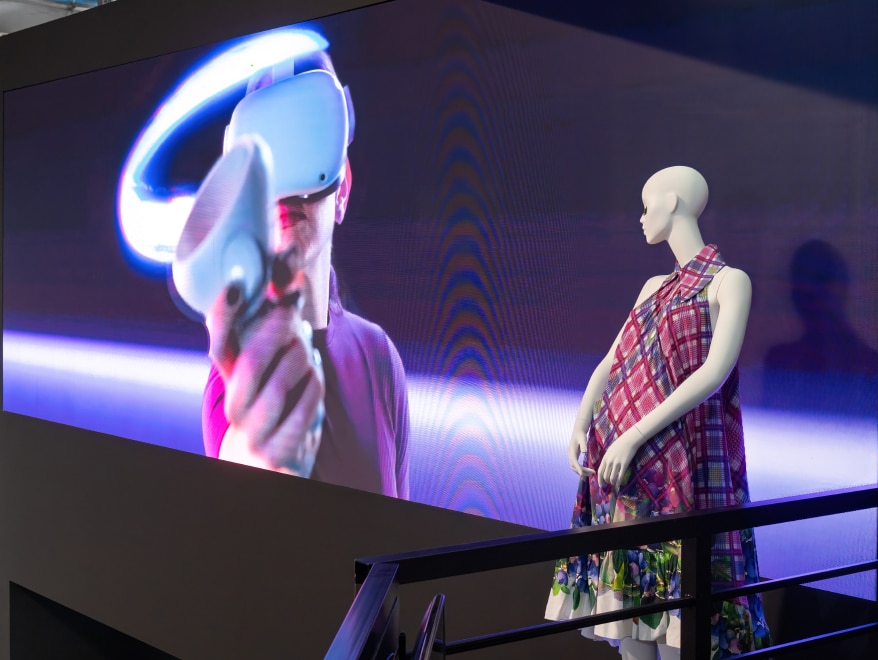IN THE LEGACY FASHION and textile industry, offshoring, waste, and inefficiency are the rule, not the exception. In fact, the World Economic Forum estimates fashion and textiles make up 10 percent of the world’s carbon emissions, and more than 85 percent of all textiles produced go into dumpsters each year.
Little is being done to change this dynamic. On the contrary, the Harvard Business Review notes the industry is actually moving backwards, with reports indicating the call for sustainable fashion hasn’t translated to action. Shorts and shoes create more waste than ever before, with 75 percent of these items ultimately being burned or buried in landfills.
However, the good news is that the demand side of the market is likely to become a major driving force of targeted, measurable, industry-wide change. Mass customization, the velocity of changing customer preferences, and the need to respond immediately will force more nearshore and onshore production. This is the only way brands and creatives can compete in this new demand model.
The creator economy accelerated dramatically in the wake of the pandemic. The digital-native generation has come of age, and their revolutionary mindset is making its presence felt. According to Statista, TikTok grew nearly twofold among those aged 15-25 after COVID hit, and brands are challenged to effectively engage these new creators (and consumers). One of our most successful customers, a custom-designed fabrics provider called Spoonflower (now a subsidiary of Shutterfly) once spoke of an “Etsy army” that had populated their design library with 1.8 million digital creations for on-demand fashioning into garments, accessories, home goods, and other digitally printed textiles.
The music industry is an apt example of how the culture of immediacy is finally matched by the technology and processes to make it happen. When a song plays, it elicits specific emotions, and listeners want to keep that feeling going. They can now do so by downloading songs or videos quickly and easily. In short, industry can now move at the speed of culture.
Advertisement

This change is ongoing across almost all creative industries. From music to art, consumers get what they want when they want it. Unfortunately, fashion and apparel has yet to catch up. “Chasing trends is impossible with an analog supply chain, where the lead time is 6-8 months,” says William Brenninkmeyer, Global Sourcing Manager and Lead of Innovation at European retail powerhouse C&A. “But digital production technologies now enable on-demand fulfillment, so you can bring concepts to production to consumer in two days. It’s incredible.”
By empowering producers to channel digital creator and consumer data encompassing buying behaviors, social media listening, and more into a fulfillment strategy, digital on-demand production answers demand for a digital supply chain with greater agility and efficacy than the traditional 18-month forecast cycle. It also answers the sustainability imperative by aligning supply with demand to minimize the inevitable waste of forecast-based production. Customization and personalization become accessible for micro-communities and even individuals. Retailers like C&A have potential to capitalize on the cultural zeitgeist.
“The analog supply chain was built to meet a certain need at a certain time, but that world has been disrupted by a cultural shift,” says Aaron Day, CEO of Amaze Software. “When you account for all the associated costs, I think we’re nearing a tipping point where an on-demand T-shirt can be produced cheaper than one produced using a traditional printing press.”
For those just entering the industry, adopting digital processes might not be that difficult. Companies leading with digital production can fully embrace “phygital” technology, which bridges the gap between digitally created imagery and physical fulfillment. This is also a natural fit for brands with a considerable e-commerce footprint. But what about retailers relying on physical, brick-and-mortar stores and the physical supply chain?
Consider C&A. With more than 1,200 physical locations worldwide, the more than 180-year-old company embodies every attribute of powerful retail production. And yet, it is still vulnerable in the age of a web-driven “retail apocalypse.” Counterintuitively, such a business sees considerable upside in Web3 technologies that can help tap into both emerging consumer trends and individualized content creation.

According to Brenninkmeyer, C&A is investing heavily in digitization to drive “rightshoring” for tailoring fulfillment strategies for different customers and brands. On-demand, digital production enables more rapid adoption of nearshoring to eliminate supply chain disruptions and to capitalize on demand for sustainability and efficiency. By simultaneously ensuring robust profit margins, this approach also enables sidestepping concerns about “greenwashing.”
The shift is playing out industry-wide. Consider legacy brands like Nike and Gucci, which are going “all-in” on Non-fungible tokens (NFTs) and artificial intelligence. These brands realize the culture is demanding change in the way creators engage and produce. For them, it may not be a matter of fully adopting digital supply chains, but rather adopting the pieces that work best for them.
From the designer who came of age in a digital world to the legacy retailer established before the advent of streetlights, brands of all sorts can leverage the growing ecosystem of available digital technologies. In doing so, they can join and profit from the creator economy; deliver uncompromising, high-quality physical goods; and better align demand with supply to eliminate overproduction waste. They can make what people want, deliver faster, and minimize the risks associated with today’s globalized marketplace.
And it’s all happening now … moving fashion at the speed of digital culture.
Advertisement


 Case Studies2 months ago
Case Studies2 months ago
 Art, Ad, or Alchemy2 months ago
Art, Ad, or Alchemy2 months ago
 Andy MacDougall2 months ago
Andy MacDougall2 months ago
 Columns3 weeks ago
Columns3 weeks ago
 Editor's Note3 weeks ago
Editor's Note3 weeks ago
 Marshall Atkinson3 weeks ago
Marshall Atkinson3 weeks ago
 Thomas Trimingham2 months ago
Thomas Trimingham2 months ago
 Case Studies3 weeks ago
Case Studies3 weeks ago


















